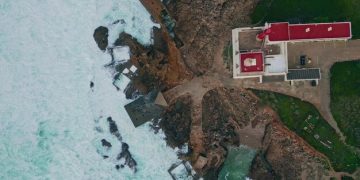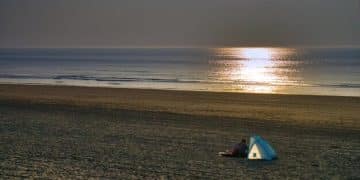Beach Bonfire Safety: Regulations & Best Practices
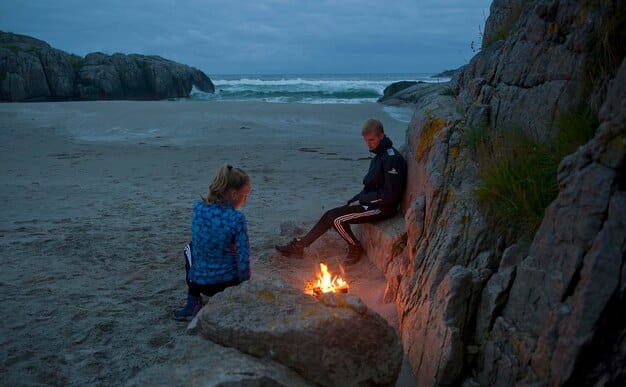
Navigating the nuances of beach bonfire regulations and adopting best practices is essential for a safe, enjoyable, and environmentally responsible evening by the shore, ensuring compliance with local laws and minimizing ecological impact.
There’s an undeniable allure to a beach bonfire – the crackling flames, the warmth against the evening chill, and the mesmerizing dance of light on the waves. It’s a quintessential coastal experience, offering moments of tranquility and connection. However, enjoying this tradition safely and responsibly hinges on understanding and adhering to Beach Bonfire Safety: Regulations and Best Practices for a Memorable Night. Not all beaches permit bonfires, and even where allowed, specific rules are often in place to protect both people and the environment.
Understanding Local Beach Bonfire Regulations
Before you even think about gathering wood for a beach bonfire, the single most critical step is to investigate local regulations. Many coastal areas have stringent rules, or outright bans, on open fires due to environmental concerns, fire hazards, and maintaining public order. These regulations can vary significantly from one beach to another, even within the same state or county. What’s allowed on one stretch of sand might be strictly prohibited just a few miles down the coast. Ignoring these rules can lead to hefty fines, legal consequences, and even public safety risks. It’s not just about avoiding trouble; it’s about being a responsible visitor.
Local authorities, such as city parks and recreation departments, state park services, or even federal land management agencies, are usually the custodians of these regulations. Their websites are often the best starting point for information. Look specifically for terms like “fire restrictions,” “open burning permits,” or “beach use policies.” Some popular beaches may have dedicated pages outlining their specific bonfire rules, including designated fire pits, time restrictions, and types of fuel allowed.
Checking Official Sources
To ensure you have the most up-to-date and accurate information, always consult official government or park service websites. Third-party sites or social media posts, while sometimes helpful, might contain outdated or incorrect information. A quick search using the beach name plus “bonfire rules” or “fire regulations” should direct you to authoritative sources. Some common points of regulation include:
- Permit Requirements: Many locations require you to obtain a permit before lighting a bonfire. These permits often come with specific conditions, such as the size of the fire, the time it can be lit, and the supervision required.
- Designated Fire Pits: Some beaches only allow fires within established, permanent fire rings or pits. Using these ensures the fire is contained and helps prevent embers from spreading.
- Time Restrictions: Bonfires are often restricted to certain hours, typically from late afternoon until late evening, to minimize disturbance and allow for clean-up.
It is essential to note that these regulations are not static. Fire bans can be implemented suddenly due to high winds, dry conditions, or increased fire risk, especially during certain seasons. Always re-check the rules immediately before your planned bonfire, even if you’ve visited the beach before. This diligence ensures your plans align with current safety advisories and protects the coastal environment.
Ultimately, respecting local regulations is about more than just compliance; it’s a fundamental aspect of being a good steward of our shared natural spaces. By doing your homework, you contribute to preserving the beauty and safety of beaches for everyone.
Choosing the Right Location and Materials
Once you’ve confirmed that bonfires are permitted and you understand the specific local regulations, the next crucial step is selecting the ideal spot on the beach and gathering appropriate materials. This forethought significantly contributes to both safety and environmental protection. An improperly located or constructed bonfire can quickly become a hazard, so careful planning is paramount for a seamless and memorable evening.
When scouting a location, prioritize designated fire pits if they are available. These pre-existing structures are purposefully designed to contain fires, reducing the risk of accidental spread. If no designated pits exist, choose a spot well away from any dry vegetation, dunes, or structures. The ocean breeze, while refreshing, can quickly fan embers, so maintaining a safe distance from anything flammable is non-negotiable. Look for a flat, open area on the wet sand, as this provides a stable, non-combustible base. Ensure it’s far enough from the water’s edge to avoid the incoming tide extinguishing your fire or—worse—carrying hot embers into the ocean.
Safe Practices for Fire Placement
The placement of your bonfire requires consideration of several environmental factors. The wind direction is a critical element, as strong gusts can scatter sparks and ash over a wide area. Try to position your fire in a spot where prevailing winds will carry smoke and embers away from people, buildings, or sensitive natural areas. Always have a clear perimeter around your fire area, free of anything combustible. This creates a buffer zone that offers additional protection against accidental spread. Think of it as creating a “defensible space” around your enjoyment.
- Wind Awareness: Position your fire downwind from any potential hazards or people. Monitor wind conditions continuously.
- Clearing the Area: Remove all debris, including dry grass, driftwood, and plastic, from a radius of at least 10 feet around your fire.
- Proximity to Water: While you need to be away from the high tide line, being close enough to the water (without direct contact) allows for easy access to water for extinguishing.
When it comes to materials, only use plain, untreated wood or charcoal. Never use treated wood, painted wood, or construction debris, as these often release toxic fumes when burned. Avoid using accelerants like gasoline, kerosene, or lighter fluid to start or fuel your fire. A small amount of kindling and natural fire starters (such as paper or natural fire starter logs) is usually sufficient. Remember, the goal is a controlled, manageable flame, not an inferno. Respecting these guidelines ensures your bonfire remains a source of joy, not a cause for concern.
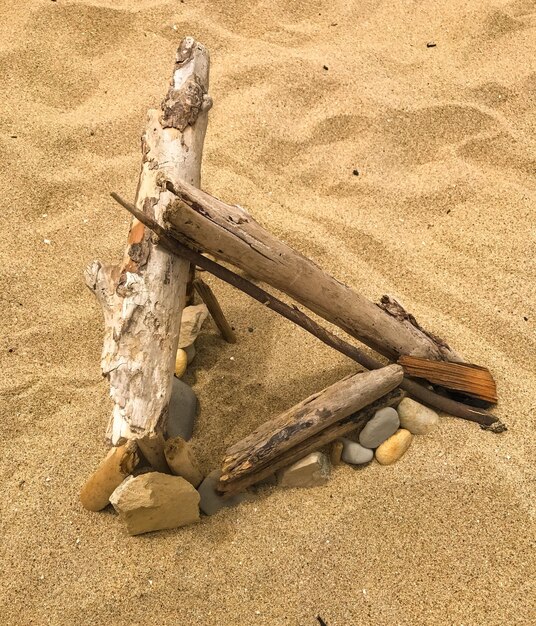
The materials you choose to burn are just as important as where you light the fire. Naturally fallen, dry driftwood is generally acceptable if permitted by local regulations. However, avoid burning any wood that appears damp or green, as it produces excessive smoke and burns inefficiently. Green wood also doesn’t provide the same warmth or ambiance as dry, aged wood. By taking these precautions and selecting your spot and materials wisely, you lay the groundwork for a safe, responsible, and truly magical beach bonfire experience.
Building and Maintaining Your Bonfire Safely
Once you’ve secured permission and chosen your ideal spot, the art of building and maintaining a beach bonfire safely comes into play. This isn’t just about stacking wood; it’s about thoughtful construction and constant vigilance to ensure the fire remains a controlled element of enjoyment, not a potential disaster. A well-built fire is safer, burns more efficiently, and provides a much more pleasant experience for everyone involved. Safety should always be your top priority throughout the entire process, from ignition to extinguishment.
Start by creating a stable base. If using a designated fire pit, simply arrange your wood within its confines. If constructing one on the sand, dig a small, shallow pit (no more than six inches deep) to act as a barrier against runaway embers. Line the pit with sand or small, non-combustible rocks if available, creating a contained area for your fire. Next, consider your wood structure. A teepee or log cabin style stack works well for beach fires. Begin with smaller kindling at the bottom, gradually adding larger pieces of wood on top. This allows for a steady progression of heat and helps the fire catch efficiently, minimizing the need for excessive accelerants.
Essential Fire Building Techniques
Igniting your bonfire should be done cautiously. Use long matches or a utility lighter to ignite the kindling. Avoid leaning over the fire or placing your face too close, as sudden flare-ups can occur. Once the fire is lit and established, a steady hand and constant supervision are key to its safe maintenance. Never leave a bonfire unattended, not even for a moment. Appoint a responsible adult to oversee the fire at all times. This ensures that any unexpected changes in wind or fire behavior can be addressed immediately.
- Start Small: Begin with kindling and gradually add larger pieces of wood as the fire grows.
- Never Leave Unattended: A responsible adult should always be within clear sight and reach of the bonfire.
- Size Matters: Keep your fire to a manageable size. Large bonfires are harder to control and present greater risks.
Beyond initial construction, continuous monitoring of wind conditions is paramount. Even if the wind was calm when you started, conditions can change rapidly. If winds pick up, it’s wise to reduce the size of your fire or even extinguish it entirely. Have a shovel or a sturdy stick nearby to rearrange logs and keep the fire contained within its boundaries. Avoid overfeeding the fire; adding too much wood at once can create excessive smoke and make it harder to control. A smaller, well-maintained fire provides plenty of warmth and ambiance without unnecessary risks, allowing you to relax and truly savor the beach experience.
Finally, avoid burning anything that could explode or release harmful chemicals. This includes aerosols, plastics, artificial logs (unless specifically designed for outdoor burning), and any form of treated wood. Sticking to natural, dry wood ensures a cleaner, safer burn that doesn’t harm the environment or compromise air quality. These practices collectively ensure that your bonfire is not only memorable but also responsibly managed from start to finish.
Safety Around the Fire: People and Surroundings
A beach bonfire is a communal experience, and just as important as managing the fire itself is ensuring the safety of everyone around it, as well as the immediate environment. Injuries can occur surprisingly quickly, and environmental damage can be long-lasting. Establishing clear boundaries and educating your group on common-sense fire safety practices are crucial steps in preventing accidents and ensuring everyone enjoys the warmth and ambiance responsibly. The dynamic nature of a beach setting, with shifting sands and unpredictable winds, further emphasizes the need for constant vigilance.
First and foremost, establish a clear safety perimeter around the bonfire. Maintain a safe distance, especially for children and pets. This distance should be large enough to prevent accidental contact with flames or embers, usually several feet beyond the edge of the fire pit. Designate a “fire tender” – a responsible adult whose primary role is to monitor the fire, feed it as needed, and ensure no one gets too close. This single point of contact helps minimize confusion and ensures consistent supervision. Remind everyone that fire is dangerous and not a toy. Teach children not to play near the fire, throw items into it, or poke it with sticks without adult supervision.
Protecting People and the Environment
Dress appropriately for a bonfire: loose-fitting clothing, especially synthetic materials, can easily catch fire. Opt for natural fibers like cotton and wool. Moreover, avoid consuming excessive alcohol or drugs around a bonfire, as impaired judgment significantly increases the risk of accidents. Have a designated sober individual to oversee the fire if alcohol is consumed by others. Consider specific precautions for windy conditions, as embers can travel surprising distances, posing a threat to both people and the wider environment. This vigilance extends beyond the immediate flame.
- Clear Perimeter: Keep a safe distance around the fire, especially for children and pets.
- Appropriate Attire: Wear natural fibers like cotton; avoid loose synthetics.
- No Impaired Judgment: Ensure someone responsible is always supervising the fire.
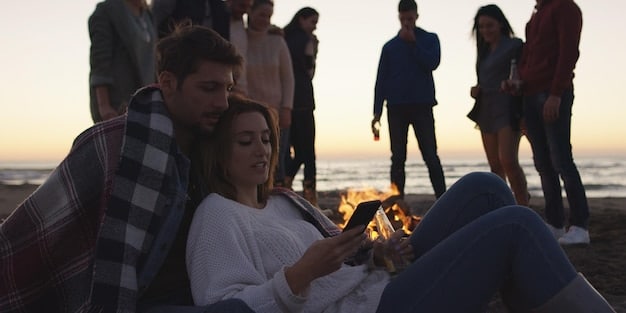
Beyond human safety, consider the environmental surroundings. Dunes, even if they appear barren, are fragile ecosystems vital for coastal stability and home to unique flora and fauna. Never build a fire on or near dunes, and ensure no embers can reach them. Avoid disturbing nesting areas for birds or other wildlife. If you’re roasting marshmallows or cooking over the fire, ensure all food waste and packaging are collected and disposed of properly. This includes fallen marshmallows or dripping sugar, which can attract wildlife or leave sticky residues. The goal is to leave the beach exactly as you found it, if not better, reflecting the principles of “Leave No Trace.”
Keeping safety in mind extends to managing potential embers and debris. Even a well-contained fire can send small, hot embers flying with an unexpected gust of wind. Having a shovel and a bucket of water or sand immediately accessible is your best defense against such occurrences. These tools allow you to quickly douse any stray sparks before they become a problem. By adhering to these safety practices, your beach bonfire can be a joyful, memorable, and entirely safe experience for everyone involved.
Proper Extinguishment and Cleanup
The journey of a safe beach bonfire culminates in its proper extinguishment and meticulous cleanup. This final phase is perhaps the most critical for safety, preventing wildfires, and preserving the pristine condition of the beach for future visitors. A fire that appears out on the surface can still harbor hot embers beneath, which could reignite hours later or injure an unsuspecting person or animal. Haste or carelessness during cleanup can undermine all the responsible planning that went into the bonfire’s creation.
Never rely solely on visual inspection to determine if a fire is out. The correct method involves a multi-step process of dousing, stirring, and feeling. First, liberally douse the embers with water. A large bucket of water is preferable to a small bottle, ensuring thorough saturation. Pour water slowly and evenly over the entire fire pit, aiming to cover every ember. You want to hear a distinct hissing sound, indicating the heat is being neutralized. If you don’t hear much hissing, add more water. The goal is to completely flood the area so that no heat remains. This initial dousing is paramount to eliminating the immediate threat.
Ensuring the Fire is Truly Out
After the initial dousing, use a shovel or a sturdy stick to thoroughly stir the ashes and embers. This exposes any remaining hot spots or hidden embers that were insulated by ash. As you stir, continue to pour more water over the disturbed areas. You’ll likely see more steam and hear additional hissing, which indicates you’re reaching previously untouched hot spots. Repeat this process – douse, stir, douse – until there is no steam and no hissing. The mixture of ash and water should resemble a thick, cold sludge, not a pile of dry, warm ash.
- Douse Thoroughly: Pour ample water over all embers until hissing stops.
- Stir and Repeat: Mix ashes to expose hidden embers and douse again.
- Feel for Heat: Use the back of your hand to check for any residual warmth.
The ultimate test for extinguishment is temperature. Carefully place the back of your hand a few inches above the ashes. If you can still feel any residual heat, the fire is not completely out, and you must continue the dousing-and-stirring process. Repeat until the entire area is cool to the touch. This method, often referred to as “cold-out,” is the gold standard for fire extinguishment. If water is scarce, use sand to smother the fire, turning and adding more sand until no heat remains. However, water is always the preferred method as sand can trap heat.
Beyond extinguishment, proper cleanup is essential. Gather all unburned wood, charcoal, and any debris that may have accumulated around the fire pit. This includes food scraps, plastic, discarded paper, and remnants of what was burned. Pack it all out, leaving no trace behind. This commitment to “Leave No Trace” principles is vital for preserving the natural beauty of the beach and respecting wildlife. By taking the time to properly extinguish and clean up, you not only ensure safety but also demonstrate responsible stewardship of our precious coastal environments, allowing others to enjoy them just as much.
Environmental Impact and Sustainable Practices
Beyond immediate safety, understanding and mitigating the environmental impact of beach bonfires is integral to responsible enjoyment. Beaches are delicate ecosystems, constantly shaped by natural forces and human activity. Every fire, every disturbance, leaves a footprint, and mindful practices ensure that our temporary pleasure doesn’t lead to lasting damage. Adopting sustainable habits ensures the very beauty that draws us to the beach remains unspoiled for generations to come. Responsible recreation integrates seamlessly with environmental preservation.
One of the primary concerns is the destruction of sensitive dune systems and coastal vegetation. These natural barriers protect inland areas from erosion and storm surges, and they provide critical habitats for a variety of plant and animal species. Building fires on or too close to dunes can destabilize them, making them more vulnerable to wind and water erosion. The heat from fires can also kill dune vegetation, which is essential for holding sand in place. Always ensure your bonfire is established well away from these fragile areas, ideally on the wet, compacted sand closer to the water (but not so close that the tide will reach it).
Minimizing Your Ecological Footprint
The type of fuel you burn also has an environmental consequence. Burning treated wood, painted wood, or trash releases toxic chemicals into the air and leaves behind harmful residues in the sand. These pollutants can contaminate the beach environment, affecting marine life and posing health risks to humans. Stick exclusively to natural, untreated driftwood or store-bought firewood. Avoid gathering live wood, as this damages living trees and contributes to deforestation. The cleaner your fuel, the smaller your carbon footprint and the healthier the beach environment remains. Consider the long-term effects of all your choices.
- Protect Dunes: Never build fires on or near dunes; they are crucial ecosystems.
- Burn Clean Fuel: Use only natural, untreated wood to avoid toxic emissions and residues.
- Leave No Trace: Pack out all trash, including food scraps and ash, to preserve the beach.
Light pollution from bonfires can also disrupt nocturnal wildlife, especially sea turtles. Many species of sea turtles nest on beaches, and hatchlings navigate towards the brighter horizon of the ocean. Artificial light from bonfires can disorient them, causing them to crawl inland where they are vulnerable to predators or dehydration. If you are on a nesting beach during nesting season, consider foregoing a bonfire entirely or opting for low-impact lighting alternatives. Check with local wildlife authorities for specific guidelines in your area.
Finally, the “Leave No Trace” principle is paramount. This means packing out everything you pack in, including all trash, food waste, and even cooled ash and charcoal. Ashes, even when cold, can alter the sand’s chemistry and impact marine ecosystems. Do not bury hot coals or trash in the sand, as this can injure others or pollute the environment. The goal is to leave the beach as if you were never there, ensuring its beauty and ecological integrity are maintained for future enjoyment and for the delicate balance of its natural inhabitants. Your responsibility in this regard is a direct contribution to preserving these treasured natural spaces.
Dealing with Unexpected Incidents and Emergency Preparedness
While meticulous planning and adherence to best practices can significantly reduce risks, unexpected incidents can still occur during a beach bonfire. From an unforeseen gust of wind scattering embers to a minor burn, being prepared for emergencies is a critical part of responsible fire safety. Knowing how to react calmly and effectively in a crisis can prevent minor issues from escalating into major problems, protecting both people and the environment. Preparedness is the final, essential layer of defense that ensures a truly safe and memorable experience.
Always have a “fire kit” readily accessible. This should include essential items for both fire management and basic first aid. For fire control, a large bucket full of water (or a reliable water source nearby), a shovel, and even a fire extinguisher rated for wood fires (Type A or ABC) are invaluable. These tools allow you to quickly contain or extinguish a fire that begins to spread unexpectedly. Position them within arm’s reach of the bonfire, not tucked away in a car or bag. Time is often of the essence when dealing with an uncontrolled flame, and quick access to resources can make all the difference.
Responding to Emergencies
For personal safety, a basic first aid kit is indispensable. This should include supplies for treating minor burns (cool water, burn gel, sterile dressings), cuts, or scrapes. In the event of a burn, immediately cool the affected area with cold water for at least 10-20 minutes. Do not apply ice directly to a burn, as this can cause further tissue damage. Seek professional medical attention for any severe burns or if pain persists. Having a fully charged cell phone is also non-negotiable. Ensure you know the local emergency number (e.g., 911 in the U.S.) and the precise location of the beach.
- Emergency Kit: Keep water bucket, shovel, and first aid supplies readily available.
- Minor Burns: Cool immediately with cold water; seek medical help for severe burns.
- Cell Phone: Have a charged phone and know emergency numbers and location.
In the event of an uncontrolled fire that spreads beyond your ability to contain it, your immediate priority shifts to personal safety. Evacuate everyone from the area, moving upwind and away from the smoke and flames. Once everyone is safe, immediately call emergency services. Provide clear and concise information about your location and the nature of the emergency. Do not attempt to fight a fast-spreading fire on your own; leave it to trained professionals. Your life and the lives of those with you are far more important than attempting to salvage a situation that has grown out of hand.
Finally, be aware of natural hazards beyond the fire itself. Sudden changes in weather, high tides, or unexpected marine life encounters can also impact your experience. Stay informed about local weather forecasts and tidal charts. Knowing how to respond to these potential challenges, from securing your belongings against rising waters to simply being aware of your surroundings, adds another layer of preparedness. A well-prepared bonfire enthusiast is not just someone who knows how to light a fire, but someone who anticipates and plans for all contingencies, ensuring a safe and stress-free beach experience.
| Key Point | Brief Description |
|---|---|
| 📜 Permit & Regulations | Always check and adhere to local beach bonfire rules and permit requirements. |
| 📍 Safe Location | Choose designated pits or wet sand, away from dunes, vegetation, and high tide. |
| 🔥 Proper Extinguishment | Douse, stir, and douse again until all ashes are cold to the touch. |
| ♻️ Leave No Trace | Pack out all debris, including unburned wood and cooled ash, leaving the beach pristine. |
Frequently Asked Questions
▼
No, beach bonfire regulations vary significantly by state, county, and even individual beach. Many areas have outright bans, while others require permits, designate specific fire pits, or enforce time restrictions. Always check with local authorities, such as park services or city recreation departments, before planning a bonfire to avoid fines and ensure safety.
▼
Only use natural, untreated wood or charcoal. Avoid burning treated wood, painted wood, construction debris, or trash, as these can release toxic fumes or leave harmful residues. Dry, natural driftwood (if permitted by local rules) or store-bought firewood are typically the safest and most environmentally friendly options for a clean burn.
▼
To safely extinguish a bonfire, first, douse all embers thoroughly with large amounts of water until hissing stops. Then, use a shovel or stick to stir the ashes and remaining embers, constantly adding more water to expose any hidden hot spots. Repeat this process until all ashes are completely cool to the touch, indicating the fire is truly out.
▼
Cleaning up is crucial for safety and environmental protection. Leaving hot ashes can reignite or injure unsuspecting people or wildlife. Ashes and debris also alter the beach’s natural ecosystem, attracting pests, polluting the sand, and impacting marine life. Adhering to “Leave No Trace” principles preserves the beach’s beauty and ecological health for everyone.
▼
No, never use gasoline, kerosene, lighter fluid, or other liquid accelerants to start or refuel a bonfire. These substances are highly volatile and extremely dangerous, capable of causing explosive flare-ups and severe burns. Use only safe, natural kindling and fire starters to ignite your bonfire slowly and controllably. Safety should always be the priority to prevent accidents.
Conclusion
Embarking on a beach bonfire adventure offers a unique connection to nature and cherished memories. However, its true magic lies not just in the glowing flames but in the conscientious approach taken by every participant. From diligently researching local regulations and choosing appropriate materials to meticulously building, maintaining, and extinguishing the fire, each step contributes to both safety and environmental preservation. By embracing these best practices – understanding environmental impact, ensuring crowd safety, and preparing for unforeseen circumstances – we uphold our responsibility as stewards of these beautiful coastal environments. A memorable night by the fire is ultimately a safe night, leaving no trace but the warmth of shared experiences and the enduring beauty of the beach itself. Let the glow of your bonfires be a testament to respect and responsibility, ensuring countless more evenings under the stars for generations to come, creating a sustainable tradition on our beloved sands.
